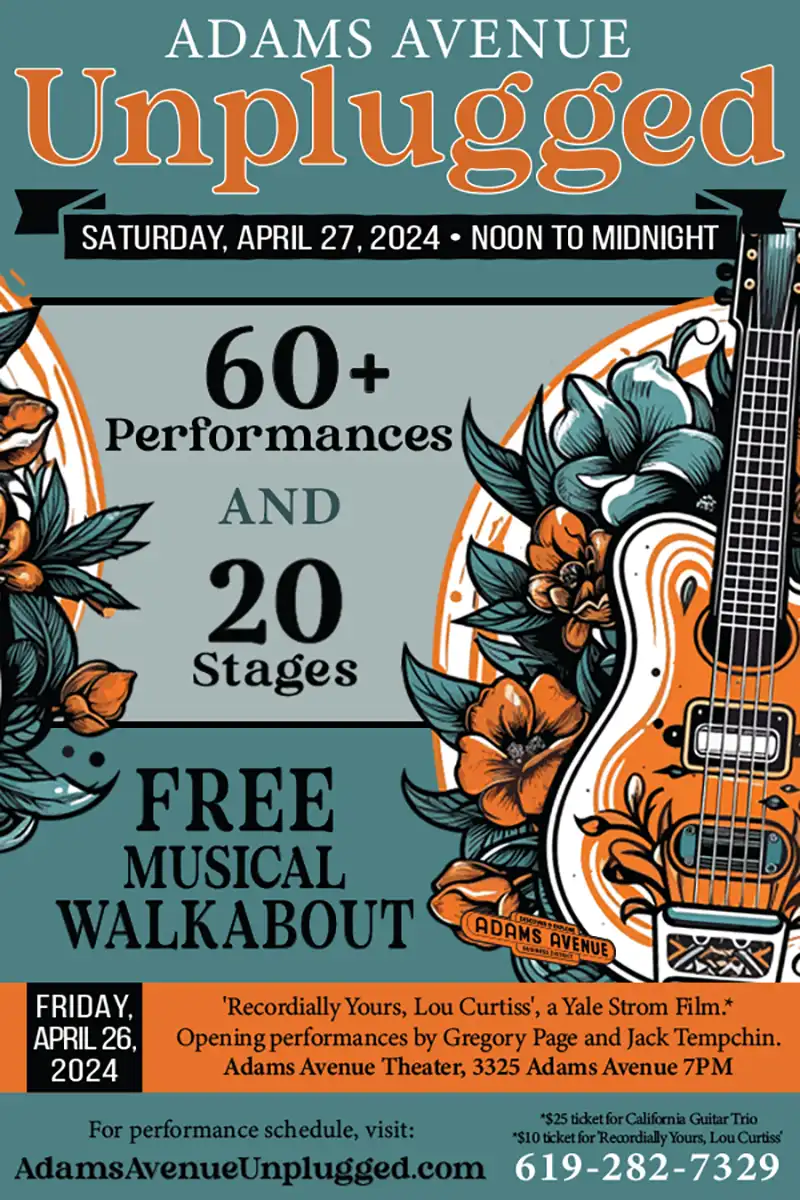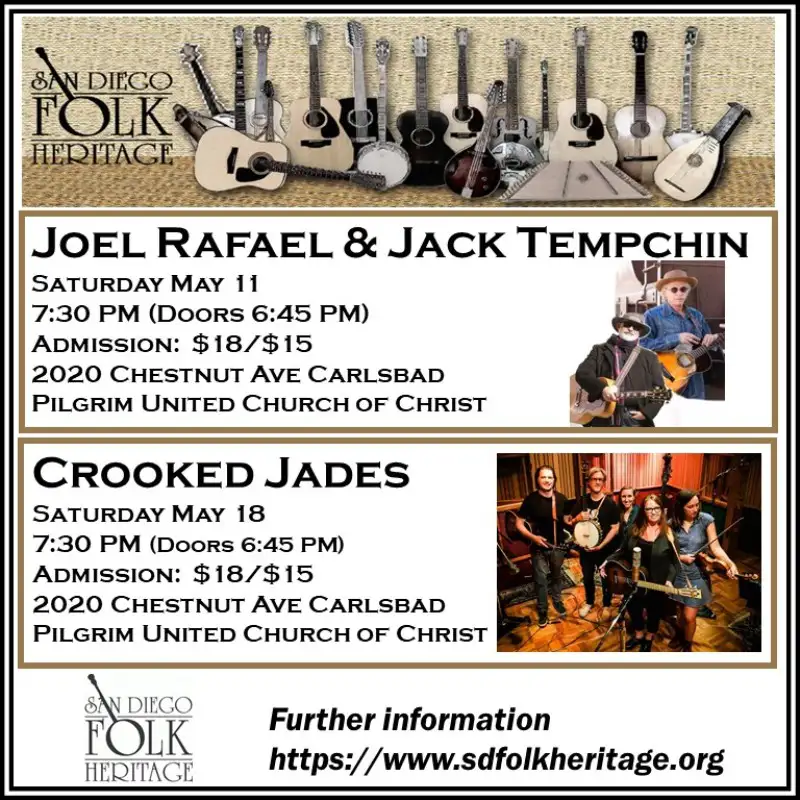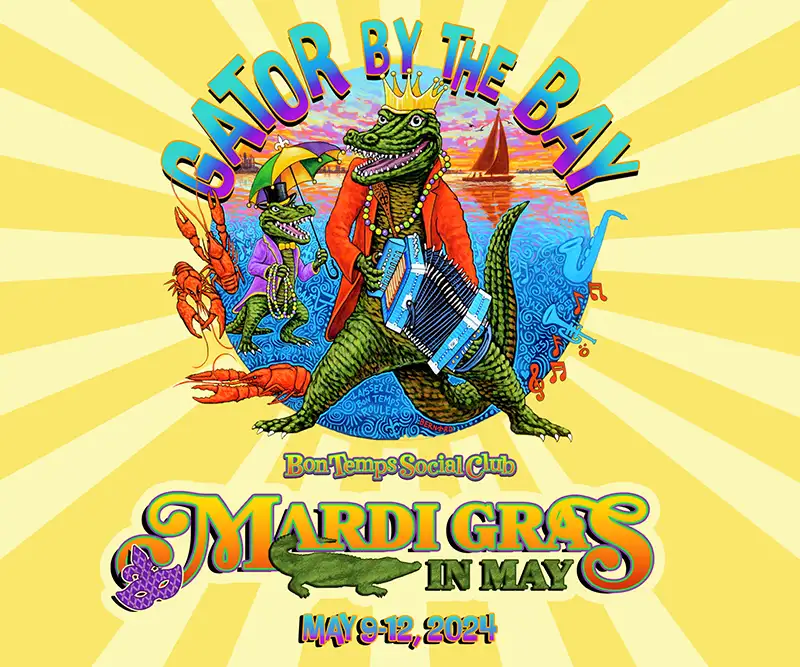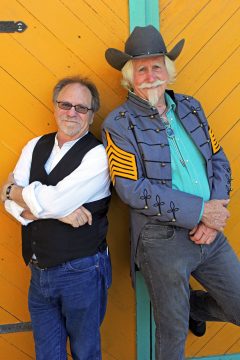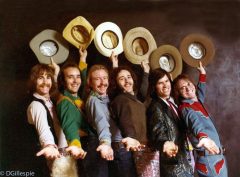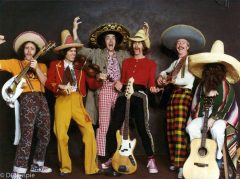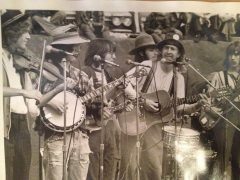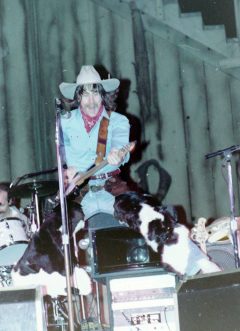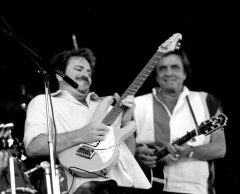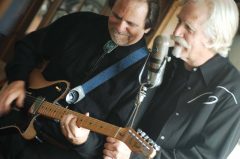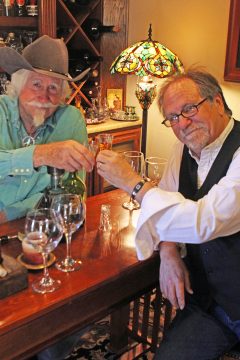Cover Story
Jim Soldi & Rick Sprahawk: Low Brows Taking the High Road–Maximum Fun with Picus Maximus
Intellectuals and resort towns make for uneasy bedfellows. Because, who wants to actually think when you’re on a work furlough? That’s a fine mindset for a week or two out of the year, but what do you do when you actually live in vacation village 24/7? Do you adopt a slacker mentality 365 days a year? Or do you attempt to elevate yourself and community to a higher standard of contemplation, values, and action? Somewhere between hedonism and heroism lies the balance. San Diego is a little slice of paradise for those who have figured out how to traverse the economic and cultural challenges that exist in the land of horchata and honey. Our streets are also littered with the human detritus of those who haven’t figured out how to stumble through this maze, and emerge triumphant on the other side.
Again, it’s all about maintaining balance and perspective, and perspective is much easier to sustain when you have a supportive partner in your life to keep your illusions in check. To have a creative partner is to experience the luxury of having someone to mirror your ideas, producing an end result than is frequently greater or more substantive than what one isolated artist can create on his own.
Illustrating that point beautifully are Jim Soldi and Rick Sparhawk, two exceptionally talented individuals who over the course of the last 50 years have elevated the regional and national music scene miles above the banal. Both gentlemen were born in San Diego, logging plenty of miles across the continent, and they continue to express themselves with as much vitality and creativity as anyone else in the business. In fact, Soldi and Sparhawk are that rare breed of artist who take their work seriously without filling the room with a bunch of blustery pretension. It’s the true musical spirit of San Diego: we’re here to have a good time, but perhaps while escaping from our troubles we can expand your purview, and start to think a little more deeply about this planet that we co-inhabit.
After plying their trade in a variety of East County high school bands, Soldi and Sparhawk joined ranks in the “bionic bluegrass” sextet Montezuma’s Revenge in 1973. They first met in 1969 when the two of them were playing in different bands at a pops concert sponsored by Monte Vista High School in Spring Valley. Sparhawk was a recent Monte Vista graduate, playing bass in Angus and the Heard; Soldi was attending El Cajon High School, playing electric guitar in a rock ‘n’ roll cover band. Sparhawk: “I’ve played bass in every band I’ve been in. My dad, Jack Sparhawk, was a jazz musician here in town. He was out of Ohio, and he settled down in San Diego after World War II. He was a musician and that’s how I started. Jim started at age one in a music store–he never started, he just was,” he says laughing.
Hey bud, you got a spud? No, fool, but I got a Kool.
Soldi: “My parents had the Valley Music store in El Cajon. In fact, Chris Hillman bought his first mandolin there. My dad, Andrew, who went by the name Cactus Soldi, was partners with a guy named Smokey Rogers. And that partnership encompassed the music store and the Bostonia Ballroom, which was kind of the go-to place for a lot of the Western Swing music that was happening in the 1950s and early ’60s. My dad had a pretty radical pedigree–he was conservatory-trained as a violinist. There’s a movie called Thank You for Smoking, and the opening track for that is Tex Williams and his Western Caravan doing “Smoke! Smoke! Smoke! (That Cigarette)” [from 1947]. My dad is the one playing the fiddle solo on that. And before he was with Tex Williams, he performed and recorded with Spade Cooley.
“My dad started the store the year before I was born, in 1952. My mom was a singer in her earlier years–she had her own radio program out of Wheeling, West Virginia. Her name was Rita, but she went by the professional name of Ginger Snow up until the time I was born. Then she retired to raise my older sister Andrea and me. We grew up in what you would think would be a very musical family, but since my dad pretty much played all the time we didn’t really play too much music at home. There was a phonograph at the house, and I listened to a lot of records, but they didn’t. I took piano lessons really early on, around the age of five. I started being able to sight-read probably before I could actually read words. But I was always drawn to the guitar, not because I really loved the guitar, but I liked the guitar player in Smokey Rogers’ band that my dad played with at the Bostonia, a guy named Tommy Turman. Eventually, I started playing school dances with a couple of friends from my high school in a rock band called Greenfield.”
A few years after graduating from high school, Sparhawk solicited a few musicians in the Casa de Oro area where he lived and asked them if they wanted to form a bluegrass group. But it was bluegrass with an absurd, irreverent twist, reflecting a fraternity rather than a conservatory. It would appear that the only thing Montezuma’s Revenge was serious about was having a good time, and doing their utmost to make sure everyone else did, too. The band members all adopted satirical alter egos: violinist Chris Vitus became “Wimpy.” Guitarist and bag-piper Charlie Rosenberger became “Zeke.” His brother Malcolm, a drummer, became “Hickey.” On banjo was Lenny Bole who became “Ty-dee Bole.” Sparhawk became “Lizard,” while Soldi became “Bosco.”
With a repertoire that balanced quirky originals with crowd-pleasing covers, it wasn’t long before they were drawing huge audiences at the Del Mar Fair and establishing a local following with a residency at Mom’s Saloon in Pacific Beach. “We would play there once a week on Mondays when we were in town,” says Sparhawk, “unless we were touring.” Along with David Bradley, and Thunderbolt the Wondercolt, Sparhawk says “The three of us owned San Diego at that time, essentially.” Soldi: “We did a lot of stuff on the fair circuit. 45-60 minute shows, and we would sometimes do three shows a day, but we always drew a big crowd.”
Sparhawk: “In 1972 we entered three contests. One was the regional country thing that KSON put on. One was the Peppergrove Bluegrass Banjo and Fiddle Contest, and the other one was some car show rock ‘n’ roll thing. We won first place for best rock ‘n’ roll band, best country band, and best bluegrass band. That was our trifecta. Dan McKinnon, the guy who owned KSON, didn’t particularly care for Montezuma’s Revenge, because we were just irreverent and obnoxious. But we won, and he had to give us our award.”
For anyone who can’t take a joke, no matter how lowbrow it might be, it is easy to understand how the aesthetics of Montezuma’s Revenge might offend those with more “delicate sensibilities.” Their debut LP from 1976, First Run, has a line drawing of a commode on the back cover with potty humor scrawled on the bathroom wall à la the cover art for the Rolling Stones’ Beggar’s Banquet. The song titles are written on a scroll of toilet tissue with each side of the album designated “No. 1” and “No. 2.” Their imprint was called Prune Records and their publishing company Breakwind Music (this was a full decade before Spinal Tap’s Break Like the Wind LP). In spite of the tongue-in-cheek nature of the presentation, the musicianship is top-notch throughout, with each member displaying masterful chops on their respective instruments. In fact, the “Bonnie and Clyde Medley” from their second LP is a fantastic mashup of styles and arrangements (the medley stitches together bits and pieces of “Wipeout,” “Surfer Joe,” “Tequila,” “Wooly Bully,” “Jungle Fever,” “Blue Suede Shoes,” “I Feel Good,” and “Sunshine of Your Love”), and demonstrates a band that is firing on all eight-cylinders, capable of handling any type of song in the field of popular music.
The title of that second LP (from 1978), Royal Flush LIVE, is another questionable pun that would have made them right at home on the Dr. Demento radio program. Which is exactly where they ended up finding an outlet for their insane sarcasm. Sparhawk: “We had a couple of numbers on his show, songs like “Looney Tune” were played a lot. We became friends to some extent with Dr. Demento.” Which makes perfect sense, since “Smoke! Smoke! Smoke! (That Cigarette)” is featured on the compilation album Dr. Demento Presents: The Greatest Novelty Records of All Time, Volume One the 1940s, along with “The Freckle Song” by Larry Vincent & his Lookout Boys, which is also covered by Montezuma’s Revenge on Royal Flush LIVE. Two generations of Soldis, with half a degree of musical separation between them.
The group’s stock rose considerably when they wound up on the first Homegrown compilation. Sparhawk: “Here’s what happened back in 1973: KGB-FM had a $1.01 concert at Jack Murphy Stadium, way before the Sky Shows. DJ Rick Leibert had gotten a copy of a song called “Chula Vista” [written by Douglas Drill, recorded by Rose & the Arrangement]. But Leibert announced that their $1.01 show had been cancelled, because the fire marshal wouldn’t let them do it anymore. So they needed to replace it with something. ‘Does anybody else have a song about their area?’ So I quickly wrote ‘Spring Valley Sally’ and sent it in, and Leibert says ‘We’re doing an album!’ Cameron Crowe, the guy who wrote and directed Almost Famous, wrote the liner notes.”
Another form of recognition for the band arrived from an unlikely source. “We used to play every summer for a number of weeks at Knott’s Berry Farm,” says Sparhawk. “This one particular year [1978] they were building a new loop de loop roller coaster, and they didn’t have a name for it yet. They liked Montezuma’s Revenge and they came to us and asked us if they could use our name. Nobody knows that, but they changed it to
z-o-o-m–Montezooma’s Revenge. We just gave it to them, it didn’t cost anything, but that’s a little bit of trivia that people don’t know. We were one of the first to ride it and it’s still there.”
On the Road Again
Sparhawk: “We had a Silver Eagle touring bus, and we had a situation one time with Montezuma’s Revenge where we were driving into Washington and we ran out of diesel. But it was on a summit, and we coasted down to a turnoff on a rest stop. We got on the CB and asked if there was a trucker who could give us a couple gallons of diesel because we only had 15 miles to get into Spokane. So this trucker stops off and we went to siphon some fuel.” Soldi: “But the only hose we had was about two feet long. And you dip it down into the tank…” Sparhawk: “And our guy from the road crew let go of the hose, and the hose went right down into the trucker’s tank. Before anybody could say a thing, Farley, our fiddle player, reaches down into this guy’s tank to grab the hose. And as soon as he makes that monkey fist he tries to bring it back up again. Have you ever looked at one of those tanks? It’s nice and smooth going down but it’s ragged and jagged at the bottom of the pipe. His arm was caught there for hours–we couldn’t get him out, we tried everything. We finally had to call a paramedic. A fire engine and a paramedic show up. It’s getting to be nighttime, the lights are flashing, and everybody on the highway is stopping to see what the action is all about. Now we’ve got an audience. The paramedic tells us he just bought a pneumatic chisel. So he proceeds to cut a gaping hole into this hundred-gallon tank of a brand new truck. We had to give the trucker all kinds of albums and t-shirts and stuff just for stopping in the first place.” Soldi: “No good deed goes unpunished!” Sparhawk: “It went punished that night. So we had to put him up for the night in Spokane, had to buy him a brand new tank, which cost us hundreds of dollars. That was an expensive gallon of fuel.”
Sparhawk continues: “We bought the bus from a Christian group, who sold it (unbeknownst to us) with a brake problem. We’d get into situations and we’d be pumping the brakes to slow down and there would be no brakes. I can’t tell you how many times we went sailing down areas with no brakes.” Soldi: “Yeah, it didn’t have a working odometer or fuel gauge, either. The first time we took that bus out on the road, we’re all sitting in the front lounge and one of our road crew comes up front and says, ‘Hey, we just lost a window in the back.’ So we ended up taking a wooden sign with Montezuma’s Revenge painted on it, and cut it to fit in the space where there was no longer a window.”
Although Montezuma’s Revenge released a trio of albums during their lifespan, both Sparhawk and Soldi left the group before the release of their third album, Suite Revenge, in 1982. It was around this time that things got really interesting for Soldi, who had developed into a first-tier journeyman guitarist for hire.
More American Than Apple Pie
Soldi: “From 1980—84 I played in a country band in El Cajon called Country Casanova–we played six nights a week at the Circle D Coral. In 1984, Johnny Paycheck came to do a show at the Circle D, and he came in with just his pedal steel player. And he hired some musicians from the musician’s union to fill out the band, kind of like what Chuck Berry would do, whom we also played with. It turns out these guys from the union were not that hip on country music. Johnny wasn’t digging it, so he fired the band and hired us for the second show on the first night and the two shows for the next night. And I got to be real friendly with Jack Smith, the pedal steel player. It was Jack who got me to Nashville, where I played in a little club in Printer’s Alley with a guy named Jimmy Snyder. I played with Snyder for about six months until that gig petered out and I moved back to San Diego. But during that time I got a call from Rodney Crowell, who at the urging of another friend of mine said why don’t you hire this guy for ‘something?’ So my first recording session in Nashville was a demo session for Rosanne Cash, produced by Rodney Crowell. And I showed up with all my stuff. I had my acoustic guitar, I had my electric rig, and Rodney says, ‘I just want you to play acoustic rhythm, I got a guy coming in to play lead guitar.’ Well, the guy he had coming in to play lead was Vince Gill. [laughs] So, that was cool–that was my first Nashville session.
“When I moved back to San Diego I started playing with another country band, and then one Saturday morning a call came in from Rodney Crowell. Rodney said that his brother-in-law was getting ready to leave Johnny Cash’s band and he needed to find a replacement–this is at the beginning of ’86. ‘Would you be interested in talking to him?’ So, about a half an hour later, Marty Stuart called. Marty was the second guitar player in Johnny Cash’s band. So I spoke to him and he wanted to see if I was interested in taking his spot in John’s band.
“He arranged for me to fly out to Nashville on Monday morning, and the idea was I’d get on a recording session for Tuesday morning and that would pay for my flight. It was at Waylon Jennings’ studio on Music Row, next to a Shoney’s. And I was in the studio, adjusting dials, and all of a sudden the hair on the back of my neck stood up. I turned around and John had just walked in the room.” It was electric from the get go? “Oh God, yes. But I had met him many times before at the Bostonia Ballroom when he came in to play.
“So, we did one song in the studio. It was the entire band, plus the Carter Family, plus Marty and I who were just hanging around outside after the session. And then Marty walks up to me and handed me the band uniform jacket and said, ‘This ought to fit, get on the bus.’ And I got on the bus that day and went straight to Grand Rapids, Michigan, for my first show. I was in the band with John for about four years. It got kind of slow toward the end after John had some health problems and ended up canceling a lot of gigs. And I would have stayed with him for a lot longer but I needed to make money, and around the same time Albert Lee recommended me for a gig with Ricky Scaggs.”
We’re Putting the Band Back Together
Sparhawk: “So, Jim had left our group and gone off to play with Johnny Cash for a number of years, and Ricky Scaggs and some others, and had come back to town and was playing with Marc Intravia.” Soldi: “I was doing a little trio thing with [keyboardist] Sharon Whyte and Marc at the Calypso in Encinitas. Early 2000s.”
Sparhawk: “Now I appreciate Jim because he’s played with Johnny Cash and I was expecting some kind of crowd for that. But there were only 15 or 20 people in the audience, and that’s just wrong. And on top of that Marc’s a great guitarist, too. And I’m saying, ‘Where is everybody? Dang it, Jim, we’ve got to make a comeback.’ Well, that year was the same year somebody found a Picus Maximus woodpecker in Arkansas, which had been extinct for 60 years. So we were extinct for a number of years just like this bird was, and if this bird can make a comeback, we can make a comeback.”
Soldi: “There’s been this gap in our collaboration between 1980 to 2004. We don’t really hang out, and we didn’t really talk to each other during that time.”
Ever since Sparhawk and Soldi reunited they have transcended the type of locker room humor that defined Montezuma’s Revenge, crafting three outstanding high-concept albums together, and are currently working on their fourth. In 2008 they released The Tragedy of Johnny Patriot, which is a mythic dream love drama with 9/11 as the backdrop. In the libretto, a journalist named Tom Harbinger goes hunting for details about a couple who died in the aftermath of the Iraqi war. Sparhawk has written a 97-page treatment of the story with the intention of turning it into a film. Sparhawk: “Johnny Patriot is a rock opera if you will. It follows the flow of a Shakespearian tragedy. I think it could be a two-hour music video. There are 16 songs, lyrically and thematically carrying the progression of the story. It’s almost like a documentary at one point, because the subplot is about this progressive magazine that wants one of their reporters to look into the death of Pope John Paul II. And during his investigation he discovers the story of Johnny Patriot.”
Regarding the political climate of a post-9/11 world, Sparhawk is neither fatalistic nor optimistic about the future. “I’m kind of agnostic about the whole thing,” he says. “But I’ve certainly had my fill of all the bipolar stuff going on: liberals against conservatives and the rabidness. It’s beyond conventional.”
9/11 is certainly a thorny subject, and it remains a challenge to sift through the holes in the official version and arrive at a definitive version of the who, the what, and the why of what went down on that day (for an impartial analysis you are advised to read journalist Christopher Bollyn’s excellent book Solving 9-11: The Deception That Changed the World). One thing is for certain: the entire subject is a political minefield and a horror story of immense proportions. Which brings us to the second Picus Maximus CD from 2012, Lullabies for the Cursed.
Lullabies for the Cursed is a Halloween-styled concept album that uses the classic Universal movie monsters of the ’30s and ’40s to explore the shadow side of existence. “I grew up going to drive-in theatres and looking at all those B-movies like The Curse of the Mummy,” says Sparhawk. For a couple of guys rooted in classic Americana, Lullabies has more than its share of crunchy guitars and heavy metalish texture. “That album was so tongue-in-cheek,” says Soldi. “There were points when we were recording it where we couldn’t actually continue because we were laughing so hard. Let’s take this over the top, with monkeys howling in the background.” Mirroring the 9/11 storyline is a song called “New World Order,” which casts a totalitarian government as a Godzilla-like character that feels perfectly cast with an array of other sonic tributes to vampires, werewolves, Frankenstein, and Martians.
After spending a season in hell, the duo decided to lighten things up on their most recent CD from 2017. A Little Love finds them returning to more traditional fare. Sparhawk: “After coming up with the concepts for the first two albums, I said let’s just do a love song album.” Soldi: “It’s a concept where we didn’t exactly have to adhere to a story line.”
“I set myself up as pretty much the producer and musical director of the thing, but the originator of the material was mainly Rick,” says Soldi. Sparhawk: “I am nothing without Jim!” Soldi: “He’s taught me a lot about…” Sparhawk: “Patience?” Soldi: “…finding a vision and making it happen, because I would have never conceived of a rock opera. And he came in with that and I think we worked pretty well together.” Sparhawk: “That was the beautiful thing about the ’70s, bands who found themselves together, collaborating like it was magic, telepathic.” Soldi: “That whole era from ’68 to the mid-’70s was so experimental.” Sparhawk: “Right now we’re grunging through the singer/songwriter thing. And you play for free for the opportunity to play your original music, because if you play original music there’s no club that is going to hire you. The clubs that hire Jim want cover material. If you come as a band with original material, there’s no audience for you, we’ve lost that.” Soldi: “And people are just not wanting to pay for music anymore. There are very few people who can actually make a living at it. Look at the San Diego County Fair: they’ll come out with a profit of millions, and they’re getting people to play it for free.”
All of the music that Picus Maximus makes is recorded in Ramona in Soldi’s studio, The Outhouse. Their method of collaborating has been fairly consistent up to this point. Soldi: “Usually Rick will come into the studio with music and lyrics and he’ll play it on guitar, and I’ll generally take it and change some of the chords around, maybe suggest some lyrical options.” Sparhawk: “He ‘matures it.’”
“But our latest album that we are now working on is pretty much Jim’s idea,” says Sparhawk. “On our next CD we’re dealing with the subject of artificial intelligence. We’re calling it Silicon Carbon Wars–the non-A.I. side of the carbon being our biological species. We sort of start off with Steam Punk, that steam train rolled in and changed everything, right? Well, the next train rolling in is A.I.” It’s a worldview that supports the idea that The Terminator isn’t science fiction, it’s a documentary, and if you listen to what is being promoted in the Top 40, the entire robotic Auto-Tune, pitch-shifting vocoder aesthetic sounds like a means for getting the public further indoctrinated into artificial intelligence. “Actually I’m getting my [conceptual] clues from a book called Our Final Invention by James Barrat,” says Soldi. “It’s all about how A.I. could end up taking over the world.” Sparhawk: “Bitcoin right now consumes more energy than the output of Ireland. So if you have an A.I. saying I need more silicon and more energy, I think I need to get rid of all this carbon over here and I’ll just grab it!” The next thing you know, Skynet has taken over. Soldi: “And that’s kind of what this book is about.”
“This current album is a totally different process than what we’ve done before,” adds Soldi. “I’m not coming in with the music,” says Sparhawk. “Jim’s laying down the music and I’m writing lyrics to that. We have seven or eight songs, but it’s still early on. Jim is so busy playing with other musicians that we’re lucky to get into the studio every couple of weeks or so. That’s why our albums take five years to make.”
Sparhawk: “When we record we lay down most of the instrumentation ourselves, but we’ll bring in some special players. Bob Sale does all the drums. John Rekevics plays saxophone.” Sparhawk does all the graphic design, producing a slick and attractive layout for all their CDs. “It’s so funny, we grew up in the era of albums, right? We love sitting down, putting on the phonograph and opening up the jacket and reading all the liner notes–it’s part of the experience, right? Then we got to CDs, where we shrunk down our footprint to five inches, and now we’re into little mini-sticks. I said, ‘Bullshit!’ I’m still going to produce compact discs.” Soldi: “You can’t buy a new car or a computer that has a CD player in it. Some people say we love vinyl because that’s what we grew up with. But if we’d grown up with CDs and went to vinyl it might not be the same experience.”
Music at Tiffany’s
Besides his skills as an artist, one of the more impressive things about Rick Sparhawk is the stunning property that he has developed on Mt. Helix with his wife Sherry. After raising three children during 38 years of marriage (and adopting two more along the way), it’s an impressive testimony to his manifestation skills and degree of compassion.
One of his current interests is developing a television show that is similar to the model provided by Daryl Hall and his program Live from Daryl’s House. Sparhawk’s living room doubles as a rehearsal/performance space and he wants to film local musicians and collaborate with them. With 35 Tiffany-styled lamps in his home he naturally wants to call the program Music at Tiffany’s. “We’ve taped one show, the pilot, but that didn’t quite come out. Technology now allows me to record with an external drive that captures 32 discrete channels. So we can put on a show here, then take the results down to Jim’s studio and remix everything–it’s totally unbelievable technology that exists now. So we did our first show a couple of months ago with Eve Selis. The concept is that us old farts are kind of backing up the newer musicians, to give some of the folks in town a chance to showcase themselves. I hooked up with Rick Bowman, the guy that did the Banjos, Bluegrass & Squirrel Barkers documentary, so he’s videotaping the whole thing. But when we did our show with Eve, the guy we hired to do the sound pushed the button on record, but didn’t realize you have to push the button and hold it to turn the line on to record. So we did the whole show and didn’t record it on our 32-track. All we have is our two-track on our camera–we can’t remix from that. So it took a lot of wind out of our sails on that project. Our original concept was to do half a dozen shows and have something to show KPBS or one of these other outlets, and maybe monetize the thing. But now Bowman is thinking about just doing one taping and see if we can drum up some interest.”
The Role of Art in the World
In addition to Picus Maximus, every month at the Tower 13 bar in Cardiff, Soldi performs with Back to the Garden, which includes his wife Sharon Whyte, Marc Intravia, Larry Grano, and Rick Nash. Regarding the music scene in San Diego, Soldi acknowledges its diversity. “If there’s a certain type of music you really want to go and hear, you can probably find it here. I cut my teeth in the country field, and there are certain forms of music that are ebbing and flowing. My particular tastes are kind of ebbing–regarding the stuff that I gravitate towards.” Perhaps it’s inevitable that as you become more of a connoisseur, you become more selective with what moves you? “Yes, but that’s the way of the world. My dad had certain preferences and I got to know pretty much what he liked. But it really shocked me when I went to visit him the year before he passed away and I had something playing on the tape deck and he asks me ‘Who is that?’ I said ‘That’s Toto.’ ‘That’s great!’ I have pretty eclectic tastes, but I don’t necessarily like a lot of the stuff that’s on the radio.
“I think the whole concept and purpose of art has changed over the years,” says Soldi. “A long time ago, art was something that elevated you. But sometimes it can tear you down. Is art that tears you down something that feeds your soul?” Sparhawk: “No, not at all. Even rap, to some extent, is a negative feeling. It doesn’t enrich me; it doesn’t make me feel good about things: being down on this person, down on that person.”
So what kind of vibe do you want to put out through your art? Sparhawk simply says “Love. Love songs.” You can’t set a clearer intention than that, can you? Now if we could only convince the other seven billion souls on the planet to feel the same way, we might be on to something.
SIDEBAR
Sparhawk: “Have you heard the story about Johnny Cash going into Valley Music one night after playing the Bostonia Ballroom?”
Soldi: “This is around ‘62, ’63. John had this Martin D28 that was all beat up and battered, and he told my dad, ‘I want to get something new.’ So my dad drove him down to the music store and opened it up after the show around 1am. Dad took a couple of guitars from out back and let him try them out. He picked out a new guitar–I think it was a Martin D35. And he asked my dad, ‘Can I trade this one in?’ Dad said, ‘Yeah.’ And before he left my dad handed him a nail and said ‘Here, sign it.’ That was in the days before Sharpies. He signed his name on his guitar with a nail, and that stayed under my dad’s bed until around 1976.
“Then I pulled it out and thought, ‘Hmm, okay. I’ll just put some Barcus-Berry pickups in this and I’ll play it. Well, long story short–it got stolen out of our fiddle player’s van. It was a 1958 Martin D28. We put up reward posters and we finally got it back from the pawnshop where these rocket scientists thought they could get some money for it. The signature was kind of problematic, so they sanded it down and used shoe polish or spray lacquer on the guitar, but they didn’t get rid of the serial number.
“In 1980 Montezuma’s Revenge was playing at the Del Mar Fair on the Fourth of July and Johnny Cash was the headliner on the main stage. So I went backstage with that guitar and I had him sign it again–this time with a Swiss army knife.
“But six years later I went to work for John and I lived right down the street from where he lived in Hendersonville, Tennessee–where the Johnny Cash Museum was. One day I was looking at the memorabilia and John walked through the museum while I was there. I said, ‘Hey, I’ve got something you might want to put up there,’ and I told him the story of where I got it and how I got it. And he looked at me and said, ‘I think that was my first guitar.’ But this was a 1958 Martin so I thought that can’t be, he’d been recording since 1955.
“So I didn’t think anything of it until after John died [09.12.03]. I was thinking it would be cool if I could show that this guitar had been used on some historic recordings. So I phoned up Marshall Grant [Cash’s longtime bassist and co-founder of the Tennessee Two] and asked him, ‘Did you guys have a set of instruments that you took on the road and a set of instruments that you kept at home for important recording sessions?’ ‘Nah, we just used what we had.’ And then I told him what I had. And he went silent, and then said ‘Man, I think you’ve got John’s first guitar.’ I said ‘How can that be?’ He said ‘Well, all through the Sun years John used my 00028 in the studio. And he had this Gibson J200 that Gibson gave him with his name engraved on the neck [as featured on the cover of The Fabulous Johnny Cash]. But John never actually went out and bought his own guitar until he got the contract with Columbia.’
“And I still have John’s first guitar.”


